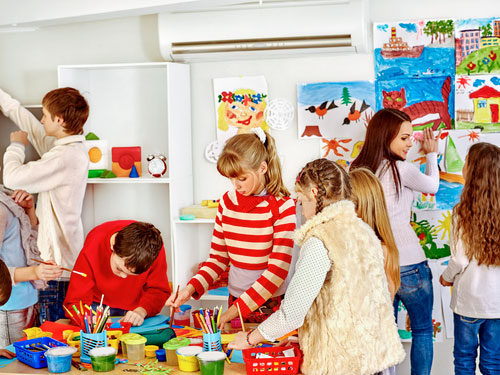
How big is the problem?
The report Bercow: Ten Years On found that the ability to communicate is fundamental to learning, to relationships and to life. More than 10% of all children and young people, over 1.4 million in the UK, have communication difficulties. They ALL need support now but specialist services aren’t available to manage this and so we need to change the way we interact, teach, and speak with them to facilitate their language development. Communication is everybody’s business and we all need to play our part.
How can I change my teaching to help the children learn?
Develop their understanding….
To be able to use words in sentences and speak, it is necessary for children to understand what is being said. In typical development understanding always comes before talking. These simple ideas below should help you to do just this.
First things first
When speaking with the children ensure they are looking at you and concentrating before you speak with them. Talking to their back is unlikely to result in understanding or action! It also means they won’t be able to see all that lovely non-verbal communication you use! So make sure that you use gestures, visuals, objects, and your facial expressions when teaching new words and ideas. You can also use other forms of non-verbal communication including symbol boards and other visuals to reinforce their learning and understanding.

Don’t overload them with information
Ensure that if you are giving them things to do that you give instructions one at a time AND in the order you want them to complete the tasks.
Reflect on how many commands you might give in one sentence. Try simplifying what you are asking so: ‘Before you go outside you need to put your book and pen in your drawer and then go to the toilet’, could be simplified to: ‘Pick up your book and pen. Put them in your drawer. Go to the toilet. Now you can go outside.’ If they find it hard to respond toone short instruction, then repeat it and add an action or a gesture. If they still don’t understand reflect on what you have asked, if it was too difficult then simplify and try again.
Say what you mean!
Tell the children what you want them to do not what you don’t want them to do. Negative statements are harder to understand. So, say, ‘Walk’ rather than, ‘Don’t run’. In this instance what they are likely to hear is ‘run’ and keep going!
Develop their memory skills
So often we try to develop children’s memory by asking them to remember things they find difficult to learn and aren’t very interested in, so it’s not surprising that they don’t remember! Consider the dinosaurs, Pokémon cards, football players etc… that they can recall when they are motivated to learn them! So, work on memory as a skill. Ask them howthey remember the things that interest them, do they visualise the object, animal or person, or maybe they repeat the name, or maybe they link it to something they already know. Once they and you understand how they remember these things then apply this style of learning to their schoolwork. You will need to make it motivating and interesting though as that’s half the battle!
Playing memory games like ‘My Granny went to the market and she bought…’ where children have to remember what previous participants have said can be fun and helpful. See how far around the classroom you can get!

Mind your language
Teachers are encouraged to question children as this promotes learning but be careful of the types of questions you are asking children who find it hard to follow what you are saying.
Most children aged 5 plus can understand ‘who, what and where’ questions but some may still find ‘why and how’challenging. So be careful of the questions you ask and provide a model of the answer for those who are struggling. For more information refer to the ‘Blank Language Scheme’ for useful tips and to develop your understanding of this complex area. We, at Elklan Training, have produced a poster which may be helpful to you, https://www.elklan.co.uk/Shop/blank_poster
How you interact does matter!
Always remember to use appropriate adult-child interaction strategies when talking with the child to ensure they have the best chance of understanding what you say. This means stop what you are doing or want them to do, listento what they are saying to you and watch what they are doing. Then respond by affirming what they have said and either following on with a comment or modelling back to develop their talking further. DON’T overloadwith lots of questions and take time for them to process what has been said to them, up to 10 seconds to allow them time to understand and make a response.

Develop their talking….
When children can talk it makes everything so much easier! It leads to fewer behavioural outbursts as it reduces frustration. There is something very easy that we can all do to help develop talking skills. The secret is ‘modelling language‘ or ‘re-casting’. Modelling is repeating back what the child says but providing an accurate example. This can be done anytime, any place and any where!
Modelling involves, repeating what the child says, putting emphasis on the words you want them to listen to and expanding the phrases so that they hear how to develop their talking further.
So in the following example, if the child says, ‘I seeed fishes in the pond’, say, ‘You saw the fish in the pond’. Emphasise slightly the words which you want the child to listen to, ‘You saw the fish in the pond’. Expand your sentence by one or two more words so that you are developing their sentence structure, e.g. ‘You saw shiny fish in the pond’.
DON’T ask them to repeat it back after you. The most important thing is that they hear the correct sentence, if you ask for it to be repeated it will be likely to come out wrong, this is counter-productive and will only add to the frustration.
In addition make sure that you wait and give children plenty of time to organise their thoughts before they talk. Have you ever tried learning a new language? If so, consider how hard it is and how long it takes to remember the words and construct a sentence, this is true for children who have SLCN when learning to talk, so give them time and encourage the other children to do that too.
All of these ideas and 100s more can be found in our Language Builders range of books available from the Elklan shop.
All these simple ideas should help develop children’s understanding and talking within the classroom so you don’t need to be taking them out and they don’t miss those all important lessons that you have worked so hard to provide.






